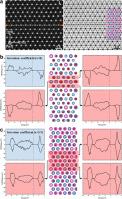当前位置:
X-MOL 学术
›
J. Mater. Sci. Technol.
›
论文详情
Our official English website, www.x-mol.net, welcomes your
feedback! (Note: you will need to create a separate account there.)
Spinel inversion-induced magnetic coupling transitions at antiphase boundaries
Journal of Materials Science & Technology ( IF 11.2 ) Pub Date : 2024-11-15 , DOI: 10.1016/j.jmst.2024.10.025 Shanshan Chen, Ziyi Sun, Qianqian Jin, Xuexi Yan, Chunyang Gao, Ang Tao, Yixiao Jiang, Tingting Yao, Chunlin Chen, Xiuliang Ma, Hengqiang Ye
Journal of Materials Science & Technology ( IF 11.2 ) Pub Date : 2024-11-15 , DOI: 10.1016/j.jmst.2024.10.025 Shanshan Chen, Ziyi Sun, Qianqian Jin, Xuexi Yan, Chunyang Gao, Ang Tao, Yixiao Jiang, Tingting Yao, Chunlin Chen, Xiuliang Ma, Hengqiang Ye

|
Clarifying how spinel inversion affects the magnetic coupling nature at antiphase boundaries (APBs) is crucial for understanding the intriguing magnetic behaviors of spinel ferrites. Here, MgFe2O4 films with an inversion coefficient of 2/3 are grown on MgO substrates using pulsed laser deposition (PLD). Investigations by state-of-the-art transmission electron microscopy suggest that two types of APBs are formed on the MgFe2O4 {110} crystal planes. The type I and type II APBs have the crystal translation of and at the boundary, respectively. First-principles calculations reveal that both type I and type II APBs tend to form antiferromagnetic coupling when the inversion coefficient in MgFe2O4 is zero. When the inversion coefficient rises to 2/3 due to the occupation of Mg2+ cations in octahedral sites, the magnetic coupling at the type I APBs changes to the ferromagnetic coupling, while the type II APBs still remain the antiferromagnetic one. The magnetic coupling modes of the APBs are closely related to the Fe–O–Fe superexchange interaction across the boundaries. Our findings clarify the atomistic mechanism of how spinel inversion affects the magnetic properties of spinel ferrites, which will promote the applications of magnetoelectricity materials with partial inversion.
中文翻译:

尖晶石反转诱导的反相边界磁耦合转变
阐明尖晶石反转如何影响反相边界 (APB) 的磁耦合性质,对于理解尖晶石铁氧体的有趣磁性行为至关重要。在这里,使用脉冲激光沉积 (PLD) 在 MgO 衬底上生长反转系数为 2/3 的 MgFe2O4 薄膜。最先进的透射电子显微镜研究表明,在 MgFe2O4 {110} 晶面上形成两种类型的 APB。I 型和 II 型 APB 具有 和 分别在边界处。第一性原理计算表明,当 MgFe2O4 中的反转系数为零时,I 型和 II 型 APBs 都倾向于形成反铁磁耦合。当由于 Mg2+ 阳离子在八面体位点占据而反转系数上升到 2/3 时,I 型 APBs 的磁耦合变为铁磁耦合,而 II 型 APBs 仍然是反铁磁的。APBs 的磁耦合模式与跨边界的 Fe-O-Fe 超交换相互作用密切相关。我们的研究结果阐明了尖晶石反转如何影响尖晶石铁氧体磁性能的原子机制,这将促进部分反转磁电材料的应用。
更新日期:2024-11-15
中文翻译:

尖晶石反转诱导的反相边界磁耦合转变
阐明尖晶石反转如何影响反相边界 (APB) 的磁耦合性质,对于理解尖晶石铁氧体的有趣磁性行为至关重要。在这里,使用脉冲激光沉积 (PLD) 在 MgO 衬底上生长反转系数为 2/3 的 MgFe2O4 薄膜。最先进的透射电子显微镜研究表明,在 MgFe2O4 {110} 晶面上形成两种类型的 APB。I 型和 II 型 APB 具有 和 分别在边界处。第一性原理计算表明,当 MgFe2O4 中的反转系数为零时,I 型和 II 型 APBs 都倾向于形成反铁磁耦合。当由于 Mg2+ 阳离子在八面体位点占据而反转系数上升到 2/3 时,I 型 APBs 的磁耦合变为铁磁耦合,而 II 型 APBs 仍然是反铁磁的。APBs 的磁耦合模式与跨边界的 Fe-O-Fe 超交换相互作用密切相关。我们的研究结果阐明了尖晶石反转如何影响尖晶石铁氧体磁性能的原子机制,这将促进部分反转磁电材料的应用。


















































 京公网安备 11010802027423号
京公网安备 11010802027423号